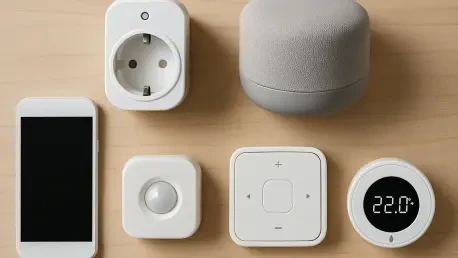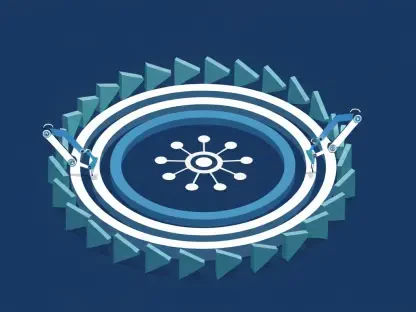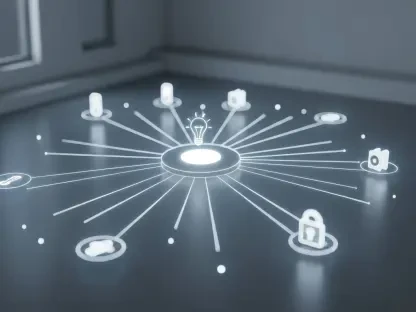The smart home market has exploded in recent years, with projections estimating that over 60% of households will adopt some form of connected technology by 2027, starting from this year. Yet, for many, the high costs and complex setups remain significant barriers to entry. Enter Ikea, a brand synonymous with budget-friendly furniture, now making waves with its ambitious foray into affordable smart home solutions. This roundup gathers opinions, tips, and reviews from various industry sources and tech enthusiasts to explore how Ikea’s innovative approach, particularly its adoption of universal standards and diverse product offerings, is reshaping perceptions of home automation. The aim is to provide a comprehensive look at whether this Swedish giant can truly democratize smart living for everyday consumers.
Exploring Ikea’s Smart Home Strategy: Diverse Perspectives
Adoption of Matter-over-Thread: A Game-Changer or Risky Bet?
Industry analysts have lauded Ikea’s decision to embrace Matter-over-Thread, a protocol designed to ensure seamless communication between smart devices across different brands. Many experts highlight that this standard could eliminate the frustration of incompatible ecosystems, allowing Ikea’s products to integrate effortlessly with platforms like Google Home or Apple HomePod. This move is seen as a bold step toward creating a unified smart home experience, potentially setting a benchmark for other manufacturers.
However, not all opinions are unanimously positive. Some tech reviewers express skepticism about the long-term reliability of such cross-brand ecosystems, pointing out that early adopters might face glitches as the technology matures. There’s also a concern among smaller tech blogs that consumer unfamiliarity with new protocols could slow adoption rates, despite the promise of interoperability. These contrasting views underscore a broader debate on whether universal standards can fully deliver on their potential without hiccups.
A balanced perspective emerges from online forums where users discuss practical implications. Many appreciate the idea of no longer needing multiple hubs for different devices, but they caution that the success of Matter-over-Thread depends on widespread industry adoption. If major players lag in implementation, Ikea’s strategy might face challenges in achieving the seamless integration it promises. This mix of optimism and caution paints a nuanced picture of the technology’s impact.
Product Range: Breadth versus Depth in Smart Solutions
Ikea’s lineup of 21 smart home devices, including Kajplats lighting, Myggspray sensors, and Bilresa remotes, has sparked varied reactions across tech communities. Reviewers from major tech publications praise the diversity of offerings, noting that products like Grillplats smart plugs, which transform regular appliances into connected devices, cater to practical needs. The range of sensors for monitoring water leaks or air quality also garners approval for addressing real-world concerns like security and energy efficiency.
On the flip side, some niche smart home bloggers argue that while the breadth of products is impressive, it risks diluting focus on perfecting individual items. They point out that competitors often specialize in fewer, highly refined devices, potentially offering superior performance in specific areas like lighting control. This critique raises questions about whether Ikea’s strategy of covering all bases might stretch its innovation too thin in a crowded market.
Consumer feedback on social platforms adds another layer to the discussion. Many first-time smart home users express excitement over the accessibility of Ikea’s solutions, citing the ability to start with simple tools like dimmable bulbs before scaling up. However, a few seasoned tech enthusiasts mention a desire for more advanced features in remotes or sensors, suggesting that Ikea’s current offerings might best serve beginners rather than tech-savvy households. This diversity in reception highlights a key tension between mass appeal and specialized functionality.
User-Friendly Innovation: Simplifying the Smart Home Experience
A recurring theme in tech reviews is Ikea’s push to make smart home tech intuitive, countering the notion that automation is inherently complex. Industry commentators note that the shift to Matter-certified products signals a future where users don’t need to navigate confusing setups or brand-specific apps. This focus on simplicity is often cited as a major draw, especially for those hesitant to dive into connected living due to perceived technical barriers.
Global consumer preferences, as discussed in various online panels, also play a role in shaping opinions on Ikea’s rollout. Sources focusing on market trends indicate that regions with high demand for affordable tech, such as parts of Europe and Asia, view Ikea’s entry as a timely solution. Yet, some market analysts warn that variations in product availability across countries could create uneven adoption, with certain innovative devices potentially delayed in less prioritized markets.
Differing viewpoints emerge when discussing long-term user engagement. While many tech influencers celebrate Ikea’s design philosophy of plug-and-play functionality, others question whether simplified systems might limit customization options for power users. This debate reflects a broader challenge in the industry: balancing ease of use with the depth that experienced consumers often seek. Ikea’s approach, while widely praised for accessibility, continues to spark discussions on where the line should be drawn.
Building on Legacy: From Furniture to Full Ecosystems
Reflecting on Ikea’s evolution, numerous industry voices acknowledge the brand’s transition from subtle tech integrations, such as air purifiers embedded in furniture, to a comprehensive smart home ecosystem. Analysts from tech-focused newsletters commend this progression, suggesting that Ikea’s consumer-centric design ethos gives it an edge over competitors who prioritize tech over usability. The ability to build on a trusted reputation for affordability is seen as a strategic advantage in gaining consumer trust.
Comparisons with competitors reveal mixed insights. Some reviewers argue that while companies like Philips Hue dominate in specialized lighting, Ikea’s broader scope and lower price points position it as a more versatile player. Others, however, caution that entering a market with established giants carries risks, including the potential for consumer overwhelm amidst too many options. These contrasting takes highlight the uncertainty of how Ikea’s past success will translate into this new arena.
Speculation on future expansions also fuels discussion. Tech trendsetters on various platforms suggest that integrating advanced AI features, like predictive automation based on user habits, could be Ikea’s next frontier. While such ideas are met with enthusiasm for their potential to redefine home living, skeptics note that scaling up too quickly might strain resources or alienate users still adapting to basic smart tech. This forward-looking dialogue keeps the conversation dynamic and open-ended.
Key Takeaways from Ikea’s Smart Home Push
Synthesizing the myriad opinions, several key points stand out about Ikea’s venture into affordable smart home tech. The commitment to Matter-over-Thread compatibility garners significant support for its promise of seamless integration, though concerns about early-stage reliability persist. The extensive product range is a highlight for its accessibility, yet it sparks debate over whether breadth compromises depth compared to niche competitors.
Practical tips for consumers emerge from community discussions and reviews. Starting with basic devices, such as smart plugs or motion sensors, is often recommended as a low-risk way to test the waters of home automation. This approach allows users to experience benefits like energy tracking or enhanced security without a hefty upfront investment, making the technology approachable for novices.
Another actionable insight focuses on integration into daily routines. Many sources suggest pairing Ikea’s lighting solutions with remotes to create personalized scenes for different times of day, enhancing comfort while conserving energy. Small, incremental steps like these are frequently cited as effective ways to maximize the value of Ikea’s offerings, catering to both budget-conscious and convenience-seeking households.
Reflecting on Ikea’s Role in Smart Living
Looking back, the discourse around Ikea’s entry into the smart home market revealed a blend of optimism and critical analysis among industry observers and consumers alike. The emphasis on affordability and universal compatibility stood out as pivotal in challenging traditional barriers to adoption. Discussions often circled around how this approach opened doors for a wider audience to engage with connected technologies.
For those intrigued by this shift, exploring further resources on smart home standards like Matter-over-Thread proved valuable in understanding the broader industry landscape. Delving into community forums and tech blogs also offered practical insights into integrating such devices effectively. These next steps helped many navigate the evolving world of home automation with confidence.
Beyond individual adoption, the conversations pointed to a larger consideration: fostering collaboration across brands to ensure truly interoperable ecosystems. Advocating for continued innovation in user-friendly design remained a common thread, as did the need to address global disparities in product access. These reflections underscored the potential for companies like Ikea to not only transform individual homes but also influence industry norms for the better.









